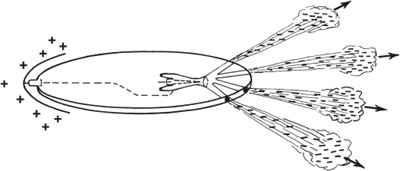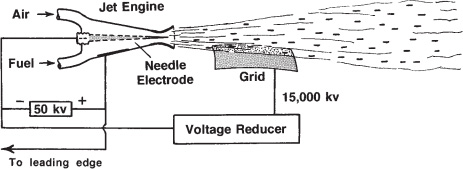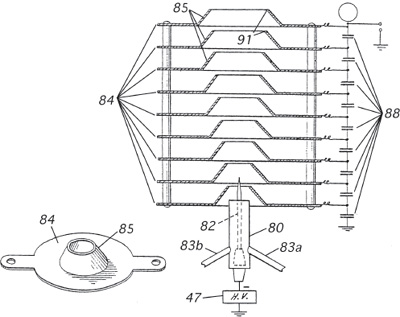Secrets of Antigravity Propulsion (8 page)

2.3 • PROJECT WINTERHAVEN
The negative evaluation that came out of the 1952 ONR investigation of Brown’s electrokinetic discs temporarily slowed down the Pentagon’s endorsement of his work, but it did not halt the eventual implementation of his electrogravitic technology.
In an effort to secure government funding, Brown wrote up a proposal in 1952 urging the Navy to initiate a highly secret project to develop a manned flying saucer as the basis of an interceptor aircraft with Mach 3 capability and proposed that this might follow along the same lines as the Manhattan District Project, which developed the atomic bomb at the end of World War II.
This confidential January 1953 submittal was code-named Project Winterhaven.
16
Extrapolating the numbers from the performance charts for Brown’s laboratory-model flying discs, Project Winterhaven estimated that larger discs operating at 5 million volts, rather than 50,000, should be able to develop speeds of 1,150 miles per hour (Mach 1.5) in the presence of atmospheric resistance and in excess of 1,800 miles per hour (Mach 2.5) in the upper atmosphere.
This rather conservative speed estimate was based on the assumption that disc speed extrapolated linearly with voltage, when in fact the evidence suggested a nonlinear relationship in which disc speed would rise exponentially with applied voltage.
Thus, considering that Brown’s 1½-foot-diameter discs had achieved speeds of twelve miles per hour when energized at 50 kilovolts, the report conservatively estimated that larger versions should be able to achieve speeds at a hundred times greater when energized at 5,000 kilovolts.
The Pearl Harbor Navy Yard demonstration, which Brown performed shortly after this proposal was submitted and was intended as a demonstration of the aviation technology he was proposing in Project Winterhaven, indicated that speeds far higher than this would be possible.
Because his 3-foot-diameter airfoils were shown to achieve speeds of several hundred miles per hour when energized at just 150 kilovolts, even a simple linear voltage-speed extrapolation would indicate that speeds of Mach 13 (10,000 miles per hour) would have been more reasonable for a 5-megavolt disc.
However, since the jet speed record at the beginning of 1953 was only Mach 1.88, Brown could guarantee Navy interest even with his more conservative speed estimates.
Project Winterhaven proposed a five- to ten-year-long research and development (R&D, or RAND) program that was to be carried out in stages.
Beginning with 2-foot-diameter discs powered at 50 kilovolts, it would proceed to 4-foot-diameter discs powered at 150 kilovolts, and finally to a 10-foot-diameter disc powered at 500 kilovolts.
The proposal also suggested making a 10-foot demonstration model capable of vertical levitation as well as horizontal thrust.
The aircraft that Brown had in mind for military development probably looked similar to the version described in his U.S.
patent 3,022,430, which was filed in July 1957 (figure 2.8).
17
Like his small-scale flying disc models, this craft produced a cloud of positive ions at its bow and a cloud of negative ions at its stern.
Brown did not discuss gravity field effects in his patents, probably because he felt that such unconventional concepts might jeopardize a patent’s ultimate acceptance.
So although his patent alludes to ion thrust as being the craft’s means of propulsion, on the basis of his own research Brown was convinced that the propulsion also involved electrogravitic effects.

Figure 2.8.
The flying disc Thomas Townsend Brown proposed for development
under Project Winterhaven may have looked like this.
(After Brown,
U.S.
patent 3,022,430, figure 1)
In parallel with this effort to develop an electrogravitic craft, Project Winterhaven also planned to investigate various methods to generate the high voltages required on board the aerospace vehicle.
The discs that Brown had flown in his carousel demonstration were energized from a heavy, high-voltage laboratory transformer powered by wall current.
A full-size airborne craft, however, would need to carry its own energy source, one capable of delivering far more power at far higher voltages than were used for this demo model.
However, a conventional turbine generator and transformer unit capable of delivering the required amount of power would have been prohibitively heavy.
Consequently, Brown took a very different approach.
He recommended investigating a device that he called a “flame-jet” electrostatic generator.
This was essentially a jet engine modified to electrify its exhaust stream, turning it into a powerful electro-hydrodynamic generator (figure 2.9, taken from Brown’s 1965 patent).
The jet engine’s exhaust nozzle was to be fitted with a negatively charged needle electrode and a positively charged plate electrode.
A 50,000-volt starter transformer located on the craft would cause the needle to emit a stream of negative ions into the jet exhaust.
The ions, however, would never succeed in reaching the nozzle’s positive electrode because they would be whisked out of the nozzle throat and away from the craft by the high-velocity exhaust gases.
The departing negative ions would acquire a very large negative voltage potential relative to the electrodes in the jet’s nozzle.
The farther they would be forced from the craft, the greater would be their potential difference.
A Van de Graaff generator, a common fixture in most high school physics laboratories, operates on a similar principle.
In that case, a rapidly running conveyor belt takes the place of the engine exhaust for transporting and separating the negative ions from the positive.
The Winterhaven proposal indicated that such an engine would be capable of generating up to 15 million volts, three hundred times higher than the 50-kilovolt input potential initially used to electrify its needle ionizer.

Figure 2.9.
A high-voltage flame-jet generator design patented by Brown.
(After Brown, U.S.
patent 3,022,430, figure 3)
By positioning a metallic grid in the exhaust stream just beyond the generator’s nozzle, some of the exiting exhaust ions could be collected at an intermediate voltage of around 1 million and, after being stepped down in voltage, could be recycled to drive the generator’s needle ionizer.
Thus, once the generator got going, the 50-kilovolt starter transformer that supplied the initial power could be turned off, leaving the generator to run itself from its own electrical output.
In the alternate design, shown in figure 2.10, the downstream exhaust grid is replaced by a series of conical baffles that become charged to successively negative potentials, with the outermost baffle being the most negative and attaining a charge of many millions of volts.
Furthermore, Brown proposed that the flame-jet generator’s positive electrode be connected to an ionizer wire running along the craft’s leading edge (see figure 2.8).
As a result, when the generator was in operation, a positive-ion space charge would build up in front of the craft, counterbalancing the negative-ion space charge built up in the exhaust plume trailing the craft.
The gravity gradient generated between these oppositely polarized ion clouds would induce a forward-pulling gravitational force.
The craft could be steered to one side or the other by diverting its exhaust through one or the other of its side nozzles, thereby producing a corresponding shift in its gravitational propulsion field.
Brown found that his flame-jet generator conveyed charges most effectively when its flame was adjusted to an orange-red color, indicating incomplete combustion of its fuel.
18
Incomplete combustion would produce large numbers of charged submicron-size particles (0.003 to 0.03 micron in diameter) that, upon being ionized, would grow in size to form Langevin ion smoke particles (> 0.03 micron).
Being much more massive than air ions, Langevin ions would move considerably slower under the influence of an electric field.
For example, in a field of 10,000 volts per centimeter, the kind Brown often worked with, Langevin ions would travel about 1 centimeter per second, as compared with 450 miles per hour for air ions.
Hence, once they are ejected from the craft, the negative exhaust ions would not readily return to the front of the aircraft to neutralize the positive ions.
Consequently, a much larger negative-ion space charge would build up behind the craft that, in turn, would substantially increase the forward-directed gravitic propulsion force.
Although the positively charged air ions produced at the front of the craft would have a much higher ionic mobility, the bow shock front that would form under high-speed flight would tend to deflect these ions away from the body of the disc, thereby retarding their rearward flight toward the negative-ion space charge cloud.

Figure 2.10.
A high-voltage flame-jet generator, a second design depicted in
Brown’s patent.
Numbers indicate the following: (47), a 50-kilovolt power
supply; (80), exhaust nozzle; (82), needle electrode; (83a and 83b), air and
fuel inlets; (84 and 85), baffles; (88), capacitors; (91), jagged electron emitter
edges.
(After Brown, U.S.
patent 3,022,430, figure 4)
The Winterhaven proposal stated that the electrogravitic motor would be essentially soundless, vibrationless, and heatless and that its internal resistance losses would be almost negligible and its speeds enormous.
The motor’s thrust could be controlled by regulating the applied voltage, and its flight velocity could be braked or even reversed simply by reversing its electric polarity.
The proposal commented that past laboratory research had indicated that an electrogravitic motor would set up a gravitational field independent of that of Earth.
Hence, an electrogravitic spacecraft could maintain sustained acceleration even after leaving the gravitational influence of Earth.
It predicted top speeds far beyond those of jet propulsion or rocket drive, with the possibility of approaching the speed of light in free space.
A 1960 report titled “Electrohydrodynamics,” issued by the Electrokinetics Corporation of Bala Cynwyd, Pennsylvania, presented an idea for a vertical takeoff aero-marine vehicle that was a variation of the one proposed in Project Winterhaven (figure 2.11).
19
The proposed vehicle was to be 24 feet high and 70 feet in diameter.
Through experimentation, Brown found that a disc whose upper surface had a triarcuateshaped profile, a helmet-shape similar to that shown in figure 2.11, produced the best vertical thrust.
